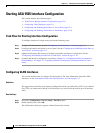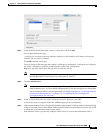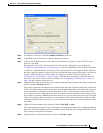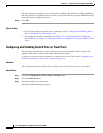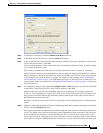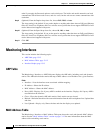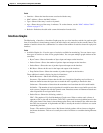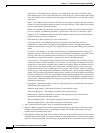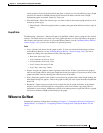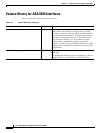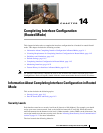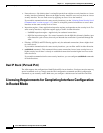
13-14
Cisco ASA 5500 Series Configuration Guide using ASDM
Chapter 13 Starting Interface Configuration (ASA 5505)
Monitoring Interfaces
Input Errors—The number of total input errors, including the other types listed here. Other
input-related errors can also cause the input error count to increase, and some datagrams might
have more than one error; therefore, this sum might exceed the number of errors listed for the
other types.
Runts—The number of packets that are discarded because they are smaller than the minimum
packet size, which is 64 bytes. Runts are usually caused by collisions. They might also be caused
by poor wiring and electrical interference.
Giants—The number of packets that are discarded because they exceed the maximum packet
size. For example, any Ethernet packet that is greater than 1518 bytes is considered a giant.
Deferred—For FastEthernet interfaces only. The number of frames that were deferred before
transmission due to activity on the link.
–
Miscellaneous—Shows statistics for received broadcasts.
–
Collision Counts—For FastEthernet interfaces only. Shows the following statistics:
Output Errors—The number of frames not transmitted because the configured maximum
number of collisions was exceeded. This counter should only increment during heavy network
traffic.
Collisions—The number of messages retransmitted due to an Ethernet collision (single and
multiple collisions). This usually occurs on an overextended LAN (Ethernet or transceiver cable
too long, more than two repeaters between stations, or too many cascaded multiport
transceivers). A packet that collides is counted only once by the output packets.
Late Collisions—The number of frames that were not transmitted because a collision occurred
outside the normal collision window. A late collision is a collision that is detected late in the
transmission of the packet. Normally, these should never happen. When two Ethernet hosts try
to talk at once, they should collide early in the packet and both back off, or the second host
should see that the first one is talking and wait. If you get a late collision, a device is jumping
in and trying to send the packet on the Ethernet while the ASA is partly finished sending the
packet. The ASA does not resend the packet, because it may have freed the buffers that held the
first part of the packet. This is not a real problem because networking protocols are designed to
cope with collisions by resending packets. However, late collisions indicate a problem exists in
your network. Common problems are large repeated networks and Ethernet networks running
beyond the specification.
–
Input Queue—Shows the number of packets in the input queue, the current and the maximum,
including the following statistics:
Hardware Input Queue—The number of packets in the hardware queue.
Software Input Queue—The number of packets in the software queue.
–
Output Queue—Shows the number of packets in the output queue, the current and the
maximum, including the following statistics:
Hardware Output Queue—The number of packets in the hardware queue.
Software Output Queue—The number of packets in the software queue.
• Add—Adds the selected statistic type to the selected graph window.
• Remove—Removes the selected statistic type from the selected graph window. This button name
changes to Delete if the item you are removing was added from another panel, and is not being
returned to the Available Graphs pane.
• Show Graphs—Shows the graph window name to which you want to add a statistic type. If you have
a graph window already open, a new graph window is listed by default. If you want to add a statistic
type to an already open graph, choose the open graph window name. The statistics already included



